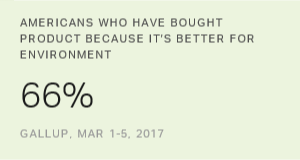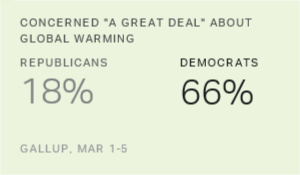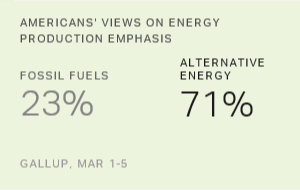Story Highlights
- 64% of Republicans say quality of environment is "excellent" or "good"
- 37% of Democrats say the same
- 53% of GOP say environment is improving; 22% of Democrats agree
WASHINGTON, D.C. -- Republicans' ratings of the overall quality of the environment in the U.S. have shifted since President Donald Trump's election. Sixty-four percent of Republicans say the quality of the environment is "excellent" or "good," up from a record-low 53% in 2016. More than one in three Democrats (37%) rate the environment this positively, similar to the 40% recorded a year ago when President Barack Obama was in office.

These results are from Â鶹´«Ã½AV's 2017 Environment poll, conducted March 1-5.
The 11-percentage-point increase from 2016 to 2017 among Republicans saying the environment is excellent or good is the largest year-to-year change in Republicans' environmental ratings since Â鶹´«Ã½AV began asking the question in 2001. The last time Republicans were this positive about the environment was in the final years of the George W. Bush administration, when more than 60% said the environment was excellent or good from 2006 to 2008.
Democrats' assessment of the environment as excellent or good is relatively unchanged in the most recent poll. Democrats have traditionally been less positive about the environment than Republicans have, and the current 27-point difference between the two groups is the highest since 2009. Still, Democrats' rating of the environment remains more positive than it was during most years of the Bush administration.
Large Partisan Gap Evident in Ratings of Environment's Direction
Republicans are also more optimistic than Democrats when asked about the future of the environment, with 53% saying it is getting better rather than getting worse, compared with 22% of Democrats. This marks a substantial change from a year ago, when the groups were essentially even, as they were throughout most of the Obama administration. There was a significant partisan gap on this item for much of the Bush administration.
Republican optimism about where the environment is headed has surged 16 points in the past year and is now at its highest level since 2004. On the other hand, the percentage of Democrats saying the environment is getting better has fallen, from 40% in 2016 to 22% in 2017.

The change in occupancy of the White House in 2009 did not have quite the same effect on partisan views of the environment. Unlike the Republican surge today, there was virtually no change between 2008 and 2009 in Democrats' perceptions about the quality of the environment after Obama took office. The percentage of Republicans rating the environment as excellent or good fell 10 points, from 65% in 2008 to 55% in 2009.
Democrats' views that the environment was improving jumped from 14% in 2008 to 39% in 2009. Democrats maintained this level of optimism throughout the Obama administration, with about four in 10 saying the environment was improving from 2009 through 2016. While currently down, environmental sentiments among Democrats have not yet fallen to the levels seen before the Obama administration.
Overall, Americans' Environmental Sentiments Little Changed
While there have been substantial shifts in environmental ratings among political groups, these have mostly canceled each other out in the overall numbers for the U.S., resulting in little perceptible change among Americans as a whole. Forty-six percent of Americans say the environment is currently excellent or good. This represents a modest decline from 50% in 2015, the high point in Â鶹´«Ã½AV's trend.

Americans typically have had negative views on the quality of the environment since Â鶹´«Ã½AV began asking them to rate it. The only year in which the percentage saying the environment was excellent or good (50%) effectively equaled that saying it was fair or poor (49%) was 2015.
Americans' outlook for the environment has also remained the same overall since 2009, despite the significant partisan shifts on this measure. Thirty-six percent of Americans say the environment is getting better, matching views in 2016. Positive sentiments on the future of the environment had jumped after Obama's election, from 26% in 2008 to 41% in 2009. So far, there has not been a corresponding dramatic shift since Trump's election.

Bottom Line
Throughout his campaign, Trump promised to roll back environmental regulations. Since he took office, he has begun following through on those promises, rallying Republicans' sentiments about the quality of the environment in the U.S. Democrats' views on the current state of the environment have changed little -- possibly because few of the new president's policies concerning the environment have yet been adopted or implemented. However, Democrats' optimism about the future of the environment has slumped.
While there have been substantial partisan shifts in environmental sentiments over the past year, there has been little change in overall views on the part of the American public in general. These partisan changes have resulted in a modest increase in positive sentiments about the current state of the environment and essentially no change in optimism about the future of the environment, despite Trump's efforts to roll back extensive environmental protections.
Historical data are available in .
Survey Methods
Results for this Â鶹´«Ã½AV poll are based on telephone interviews conducted March 1-5, 2017, with a random sample of 1,018 adults, aged 18 and older, living in all 50 U.S. states and the District of Columbia. For results based on the total sample of national adults, the margin of sampling error is ±4 percentage points at the 95% confidence level.
Each sample of national adults includes a minimum quota of 70% cellphone respondents and 30% landline respondents, with additional minimum quotas by time zone within region. Landline and cellular telephone numbers are selected using random-digit-dial methods.
View survey methodology, complete question responses and trends.
Learn more about how the works.




